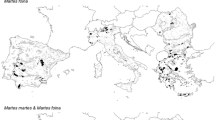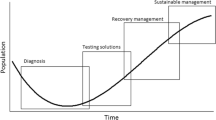This paper briefly reviews some limitations associated with the application of existing modelling procedures to conservation ecology, and describes a new procedure (DOMAIN) which avoids these problems. The procedure computes potential distributions based on a range-standardized, point-to-point similarity metric and provides a simple, robust method for modelling potential distributions of plant and animal species. DOMAIN offers advantages over similar methods in its ability to operate effectively using only presence records and a limited number of biophysical attributes. The use of a continuous similarity function gives DOMAIN increased flexibility as an heuristic tool, suitable for application in survey design, reserve selection and potential mapping of rare and common species. Potential distributions were computed for two Australian marsupial bettong species (Aepyprymnus rufescens ‘Gray’ and Bettongia tropica Wakefield) using DOMAIN and two alternative models. Of the three procedures, the DOMAIN model produced distribution patterns that were most consistent with the known ecology of the species, and most appropriate for survey design.
Similar content being viewed by others
References
Belbin, L. (1992) Comparing two sets of community data: A method for testing reserve adequacy. Aust. J. Ecol. 27, 255–62.
Booth, T.H. (1985) A new method for assisting species selection. Commonw. For. Rev. 64, 241–50.
Booth, T.H. (1990) A climatic analysis method for expert systems assisting three species introductions. Agroforestry Syst. 10, 33–45.
Booth, T.H. (1991) Plant growth and site selection: where will it grow? how will it grow? Agric. Syst. Inform. Technol. Newslett. 3.3, 30–1.
Booth, T.H. and Jovanovic, T. (1988) Assaying natural climatic variability in some Australian species with fuelwood and agroforestry potential. Commonw. For. Review 67, 27–34.
Box, E.O. (1981a) Macroclimate and Plant Forms: An Introduction to Predictive Modelling in Phytogeography. The Hague: Dr W. Junk.
Box, E.O. (1981b) Predicting physiognomic vegetation types with climate variables. Vegetatio 45, 127–39.
Brieman, L., Freidman, J.H., Olshen, R.A. and Stone, C.J. (1984) Classification and Regression Trees, Belmont: Wadsworth.
Busby, J.R. (1986) A biogeographical analysis of Nothofagus cunninghamii (Hook.) Oerst. in southeastern Australia. Aust. J. Ecol. 11, 1–7.
Gillison, A.N. and Carpenter, G. (1992) A regional sampling strategy for natural resource inventories within the Wet Tropics World Heritage Area. Unpublished report to Wet Tropics Management Agency, Cairns, Queensland.
Gower, J.C. (1971) A general coefficient of similarity and some of its properties, Biometrics 27, 857–71.
Jancey, R.C. (1980) A hyperspatial model for complex group structure. Taxon 26, 409–11.
Lillesand, T.M. and Keifer, R.W. (1987) Remote Sensing and Image Interpretation, 2nd edition. New York: John Wiley & Sons.
Nix, H.A. (1986) A biogeographic analysis of Australian elapid snakes. In Atlas of Elapid Snakes of Australia (R., Longmore, ed.) Canberra: AGPS.
Nix, H.A., Stein, J.A. and Stein, J.L. (1992) Developing an Environmental Geographic Information System for Tasmania. Canberra: Centre for Resource and Environmental Studies, Australian National University.
Nix, H.A. and Switzer, M.A., eds (1991) Rainforest Animals, Atlas of Vertebrates Endemic to Australia's Wet Tropics in Kowari No. 1. Canberra: Australian National Parks and Wildlife Service.
Shugart, H.H., Mortlock, A.T., Hopkins, M.S. and Burgess, I.P. (1980) A computer simulation model of ecological succession in Australian subtropical rainforest. Oak Ridge National Laboratory, ORNL/TM 7029.
Sutherst, R.W. and Maywald, G.F. (1985) A computerised system for matching climates in ecology. Agric. Ecosyst. Environ. 13, 281–99
Walker, P.A. and Cocks, K.D. (1991) HABITAT: a procedure for modelling a disjoint environmental envelope for a plant or animal species. Global Ecol. Biogcog. Lett. 1: 108–18.
Webb, D.B., Wood, P.J. and Smith, J.P. (1980) A guide to species selection for tropical and subtropical plantations. Tropical Forestry Paper No 15. Oxford: Commonw. For. Inst.
Author information
Authors and Affiliations
Rights and permissions
About this article
Cite this article
Carpenter, G., Gillison, A.N. & Winter, J. DOMAIN: a flexible modelling procedure for mapping potential distributions of plants and animals. Biodivers Conserv 2, 667–680 (1993). https://doi.org/10.1007/BF00051966
Received:
Revised:
Accepted:
Issue Date:
DOI: https://doi.org/10.1007/BF00051966




